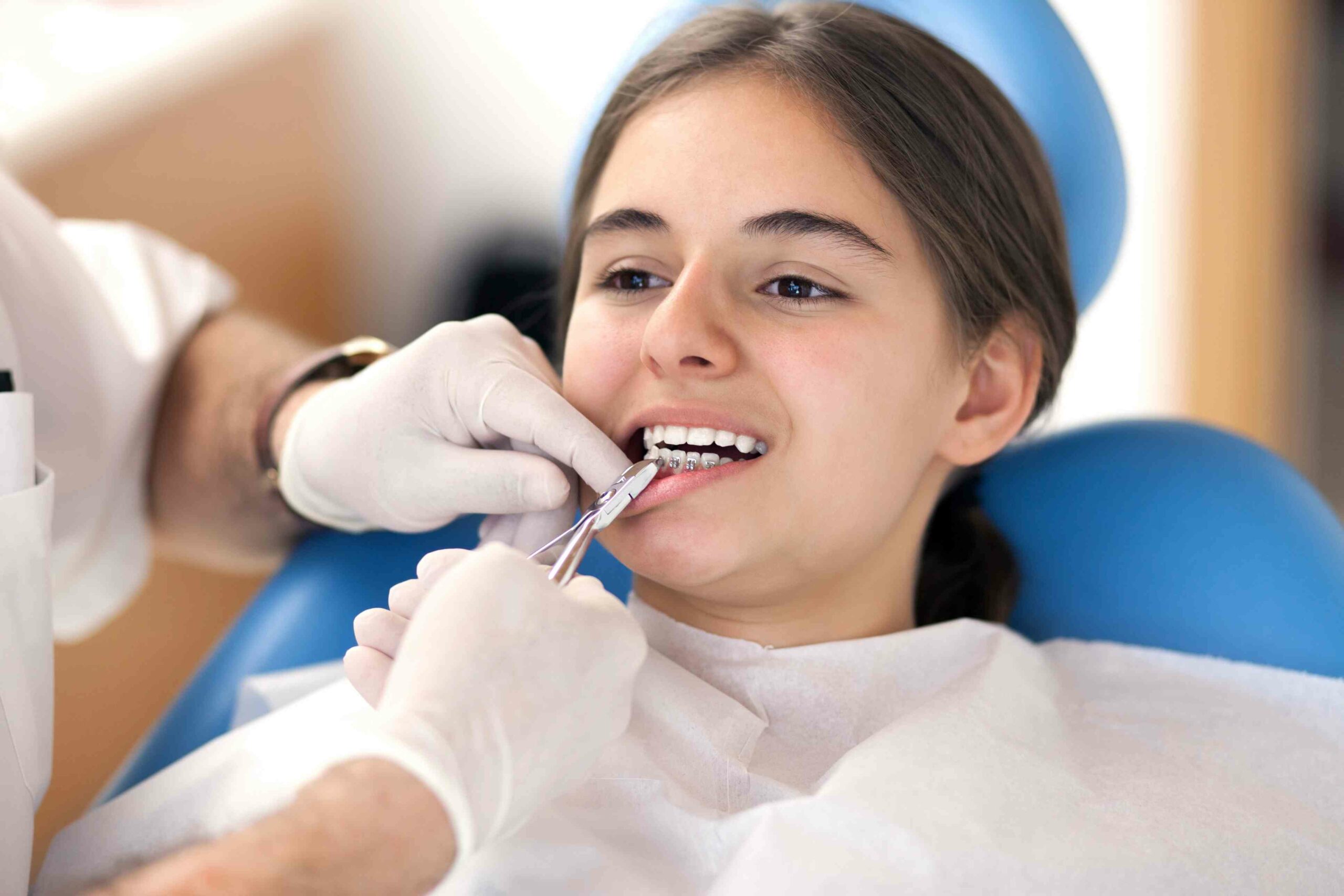
If your child has crooked teeth or a misaligned jaw, talk to your dentist. They may recommend seeing an orthodontist.An orthodontist specializes in perfecting smiles using orthodontic appliances, such as:
- Bands
- Brackets
- Wires
- Headgear
- Rubber bands
- Retainers
- Clear aligners
Types of Braces and Other Appliances
There are a number of dental appliances used today. But braces are still the primary means for straightening teeth and correcting misaligned bites in children. Braces work by applying pressure to the teeth and jaws to move them into the desired position.
Braces are not always the shiny mouthful of metal of years past. Many more options are now available.
Braces are made of materials such as:
- Stainless steel
- Ceramic
- Plastic
- Combination of materials
Invisible trays may be an option for some people who require orthodontic work. This method uses custom-made, clear, removable trays that put pressure on the teeth, moving them gradually into their correct position.
Other appliances used in orthodontics include:
TADs: Temporary anchorage devices (TADs) are mini-screws ranging from 6 to 12 millimetres in length and 1.2 to 2 millimetres in diameter. When needed they may be temporarily fixed to bone in the mouth to provide a fixed point from which to apply force to move teeth. TADs allow for more predictable tooth control. They are becoming more common in orthodontic treatment.
Rubber bands: Rubber bands are also called elastics. They are used when more force is needed to move the teeth and jaws into the desired position.Headgear: Some people can benefit from using headgear. The appliance is attached to the braces from the back of the head and can be removed. As with rubber bands, headgear is used when extra force is needed to move the teeth and jaws. If the headgear is needed, it usually only has to be worn at night while sleeping or at home.Retainers: Retainers are used to keep teeth in place once braces are removed. It takes time for your teeth to settle into their new position. By wearing a retainer, you can prevent your teeth from shifting. Some retainers may be removable. Others are fixed — bonded behind your teeth. Some retainers are made of clear plastic and metal wires. Others are made of rubber. And like braces, retainers can make a statement if you choose. There are glow-in-the-dark retainers or retainers customized with a picture.
What’s the youngest a child can get braces?
There is no set age when children require orthodontics. The treatment plan will depend on individual needs. For example, kids with cleft palates get orthodontic appliances before their first teeth erupt.
Other kids may benefit from starting treatment as early as age 6 or 7, even if they have not lost all of their baby teeth. The goal of early treatment is to prevent further problems from developing. It will create a better environment for the permanent teeth to erupt, or grow, into.
Most kids who require early orthodontics will still need braces or additional work later to complete the tooth and jaw alignment process. But the amount of work may be significantly less if orthodontic treatment was completed early.
Do braces hurt?
“Hurt” may be too strong of a word. But your child may have some discomfort when braces are first put on, when they are adjusted, or when you start using a new appliance, such as rubber bands or a headgear.
Also, if the wire, brackets, or bands irritate your child’s mouth, your orthodontist can provide special wax to cover the sharp areas on the braces.
Is it possible to be allergic to braces?
Yes. Some people are allergic to certain metals, such as nickel. When this happens, other materials can be used instead. People can also be allergic to the latex gloves used by the orthodontist and the assistants. If your child has a latex allergy, tell your dentist so that non-latex gloves can be used.
How long does my child need to wear braces?
The length of treatment varies. It depends on the problem, how well your child cooperates, and your child’s growth. Typically, most people wear braces from 18 to 36 months.
How long does my child need to wear a retainer?
Ideally, your child should wear a retainer forever, even if it is only one night a week. Of course, this may not be practical. The teeth are like the rest of the body and the body changes. Once your child stops wearing the retainer, slight changes to the teeth should be expected.Making the decision to embark on orthodontic treatment may not be easy, but an improved smile can make a huge difference in appearance and self-esteem.There are many options available. When choosing a treatment plan, you need to consider many factors, including the orthodontic needs, cost, and primary goals of treatment. Your dentist or orthodontist can help you make the right decision for you and your child.
Sources
SOURCES:
American Dental Association web site: “Braces and Orthodontics.”
American Association of Orthodontists web site: “Myths and Facts;” “All About Orthodontics;” “Elastics;” “Keeping Your Smile Beautiful After Orthodontic Treatment;” “Getting into Gear: Orthodontic Headgear;” “Temporary Anchorage Devices (TADs) for Predictable Tooth Movement;” “Two-Phase Orthodontic Treatment;” and “When to See an Orthodontist.”
Nemours Foundation web site: “Why do people need braces?” and “Affording Braces.”
Aetna web site: “Orthodontics Braces and More.”
American Academy of Cosmetic Dentistry web site: “Orthodontics and Clear Aligners.”
Leon Aronson, DDS, MS, adjunct professor of orthodontics, Medical College of Georgia; Center for Advanced Dental Education, Saint Louis University; vice president, International College of Dentists.




